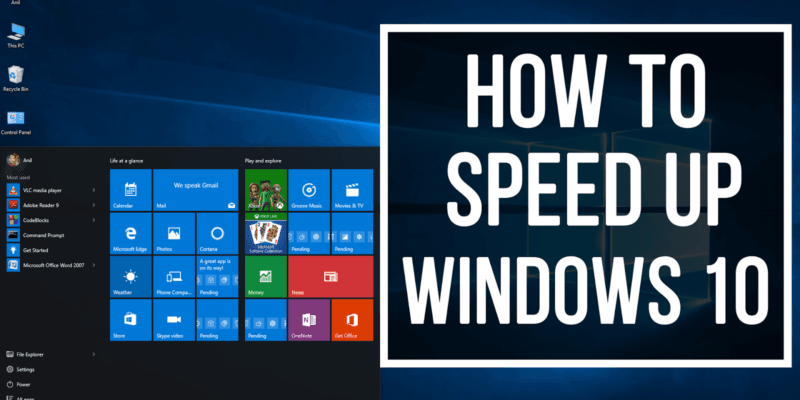We’ll get straight into it. The simplest speed up routine is to tell Windows 10 to optimise itself for performance. To do this, type:
- “Adjust” in the Start menu’s search box and click “Adjust the appearance and performance of Windows”.
- This will bring up the Performance Options properties sheet from the Control Panel.
- Select “Adjust for best performance” and Windows will drop all the fancy graphical effects such as sliding things in and out of view.
- You can use the Custom settings to retain any features you want to keep, such as “Show window contents while dragging”.
- Next, run the Control Panel, type “power” into the search box in the top right and select “Choose a power plan”.
- Most laptops are set to “Balanced”. “Power saver” will reduce performance to extend battery life. “High performance” will deliver the best performance but use more energy.
Start-up programs and services
PCs can become bogged down by the sheer number of running processes. You can easily turn off these apps and that will speed up your Windows 10.
To check your startup programs,
- open Task Manager (Ctrl + Alt + Del), then click the ‘Startup’ tab.
- Pay close attention to the ‘Startup Impact’ values for each program e.g. ‘High’ as this is a good way to spot apps that are likely to slow your system down.
- To prevent a program from launching on login just right-click and choose ‘Disable’.
Run Disk Cleanup
Disk Cleanup is an extraordinarily built-in Windows utility. You can use it to clear out temporary files which accumulate on your machines, such as image thumbnails, downloaded program files and offline webpages.
- Click the Windows menu and type ‘Disk Cleanup’ in the search bar to get started. The utility will offer you a choice of files to remove.
- Simply mark the checkbox next to each option. Click ‘Clean up system Files’ to begin.
- Disk Cleanup will calculate the amount of space you will save.
This is also a good opportunity to delete any files on your hard drive which you no longer need. An easy place to start is your ‘Downloads’ folder.
Remove unused software
Many PC vendors ship their machines with bundled third party software, which due to its large size and unnecessary nature is sometimes referred to as ‘Bloatware’. Many computer users also install software for a specific purpose and never use it again e.g. designing a newsletter.
Redundant programs take up space on your hard drive and can reduce performance. To check your installed apps go to
- ‘Control Panel’>’Programs’>’Programs and Features’>’Uninstall a Program’.
- Right-click on any programs you no longer need and select ‘Uninstall’. Windows 10 will ask for permission to make changes to your system. Click ‘Yes’ to continue.
Upgrade your RAM
Your Windows 10 overall speed can be hugely improved by increasing the amount of virtual memory (RAM). Windows 10 requires a minimum of 4GB to run smoothly, although this does not take into account resource-hungry applications such as video games.
The easiest solution to this is to install more RAM. Your PC has a certain number of RAM ‘slots’ into which you can insert chips. To determine the type of memory your machine uses, open Task Manager (Ctrl + Alt + Del), then click ‘Performance’. The system will display any memory slots in use as well as the type used e.g. DDR4.
Installing new RAM chips is quite simple. If you do it yourself use an anti-static wrist strap to prevent damage to delicate components. Alternatively, many PC repair stores will be happy to do the hardware upgrade for you, for a small fee.
Use an SSD
SSDs (Solid State Drives) use Flash memory, the same kind found in USB sticks. They allow for much faster access and writing times than traditional mechanical hard drives which use magnetized disks.
SSDs do cost much more per GB than regular hard drives, but if you’re are willing to pay the cost, you’ll notice a huge improvement in boot time, files access times and overall system responsiveness.
If you want to buy an SSD to install yourself make sure you have the correct size for your machine (2.5″ for portable devices, 3,5″ for desktop machines). You can use free software such a Clonezilla to copy content form your current hard disk to your new SSD. See our guide on how to clone your hard drive with Clonezilla.
Run System Maintenance
Windows 10 has a built-in utility which performs routine system maintenance tasks such as defragmenting the hard drive, scanning for updates, and checking for malware.
These tasks usually run in the background while your PC is idle but if you have noticed an issue with system performance you can run maintenance manually if you wish.
To get started, open Control Panel, select ‘System and Security’ then choose ‘Security and Maintenance’. Click the arrow to expand the maintenance options. From here you can select ‘Start Maintenance’. Close and save any open files before going ahead.






Comments